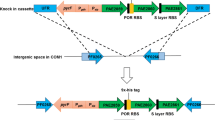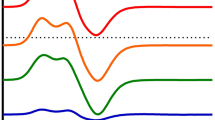Abstract
Methanopyrus kandleri belongs to a novel group of abyssal methanogenic archaebacteria that can grow at 110°C on H2 and CO2 and that shows no close phylogenetic relationship to any methanogens known so far. N 5 N 10-Methylenetetrahydromethanopterin reductase, an enzyme involved in methanogenesis from CO2, was purified from this hyperthermophile. The apparent molecular mass of the native enzyme was found to be 300 kDa. Sodium dodecylsulfate/polyacrylamide gel electrophoresis revealed the presence of only one polypeptide of apparent molecular mass 38 kDa. The ultraviolet/visible spectrum of the enzyme was almost identical to that of albumin indicating the absence of a chromophoric prosthetic group. The reductase was specific for reduced coenzyme F420 as electron donor; NADH, NADPH or reduced dyes could not substitute for the 5-deazaflavin. The catalytic mechanism was found to be of the ternary complex type as deduced from initial velocity plots. V max at 65°C and pH 6.8 was 435 U/mg (kcat=275 s-1) and the K m for methylenetetrahydro-methanopterin and for reduced F420 were 6 μM and 4 μM, respectively. From Arrhenius plots an activation energy of 34 kJ/mol was determined. The Q 10 between 40°C and 90°C was 1.5.
The reductase activity was found to be stimulated over 100-fold by sulfate and by phosphate. Maximal stimulation (100-fold) was observed at a sulfate concentration of 2.2 M and at a phosphate concentration of 2.5 M. Sodium-, potassium-, and ammonium salts of these anions were equally effective. Chloride, however, could not substitute for sulfate or phosphate in stimulating the enzyme activity.
The thermostability of the reductase was found to be very low in the absence of salts. In their presence, however, the reductase was highly thermostable. Salt concentrations between 0.1 M and 1.5 M were required for maximal stability. Potassium salts proved more effective than ammonium salts, and the latter more effective than sodium salts in stabilizing the enzyme activity. The anion was of less importance.
The N-terminal amino acid sequence of the reductase from M. kandleri was determined and compared with that of the enzyme from Methanobacterium thermoautotrophicum and Methanosarcina barkeri. Significant similarity was found.
Similar content being viewed by others
Abbreviations
- H4MPT:
-
tetrahydromethanopterin
- CH2=H4MPT:
-
N 5 ,N 10-methylene-H4MPT
- CH3-H4MPT:
-
N 5-methyl-H4MPT
- CH≡H4MPT+ :
-
N 5 ,N 10-methenyl-H4MPT
- F420 :
-
coenzyme F420; 1 U=1 μmol/min
References
Bio-Rad Laboratories (1981) Instruction manual for Bio-Rad protein assay, Bio-Rad Laboratories, Richmond, Calif., USA
Bradfor MM (1976) A rapid and sensitive method for the quantitation of microgram quantities of protein utilizing the principle of protein-dye binding. Anal Biochem 72: 248–254
Cleland WW (1970) Steady-state kinetics. In: Boyer PD (ed) The enzymes. Academic Press, New York, London, pp 1–65
DiMarco AA, Bobik TA, Wolfe RS (1990) Unusual coenzymes of methanogenesis. Annu Rev Biochem 59: 355–394
Escalante-Semerena JC, Leigh JA, RinehartJr KL, Wolfe RS (1984a) Formaldehyde activation factor, tetrahydromethanopterin, a coenzyme of methanogenesis. Proc Natl Acad Sci USA 81: 1976–1980
Escalante-Semerena JC, RinehartJr KL, Wolfe RS (1984b) Tetrahydromethanopterin, a carbon carrier in methanogenesis. J Biol Chem 259: 9447–9455
Hensel R, König H (1988) Thermoadaptation of methanogenic bacteria by intracellular ion concentration. FEMS Microbiol Lett 49: 75–79
Hewick RM, Hunkapiller MW, Hood LE, Dreyer WJ (1981) A gasliquid solid phase peptide and protein sequenator. J Biol Chem 256: 7990–7997
Huber R, Kurr M, Jannasch HW, Stetter KO (1989) A novel group of abyssal methanogenic archaebacteria (Methanopyrus) growing at 110°C. Nature 342: 833–834
Kanodia S, Roberts MF (1983) Methanophosphagen: unique cyclic pyrophosphate isolated from Methanobacterium thermoautotrophicum. Proc Natl Acad Sci USA 80: 5217–5221
Laemmli UK (1970) Cleavage of structural proteins during the assembly of the head of bacteriophage T4. Nature 227: 680–685
LeGendre N, Matsudaira P (1988) Direct protein microsequencing from Immobilon-P transfer membrane. BioTechniques 6: 154–159
Ma K, Thauer RK (1990a) Purification and properties of N 5 ,N 10-methylenetetrahydromethanopterin reductase from Methanobacterium thermoautotrophicum (strain Marburg). Eur J Biochem 191: 187–193
Ma K, Thauer RK (1990b) Single step purification of methylene-tetrahydromethanopterin reductase from Methanobacterium thermoautotrophicum by specific binding to Blue Sepharose CL-6B. FEBS Lett 268: 59–62
Ma K, Thauer RK (1990c) N 5 ,N 10-Methylenetetrahydromethanopterin reductase from Methanosarcina barkeri. FEMS Microbiol Lett 70: 119–124
Perrin DD, Dempsey B (1974) Buffers for pH and metal ion control. Chapman and Hall Laboratory, London
Schwörer B, Thauer RK (1991) Activities of formylmethanofuran dehydrogenase, methylenetetrahydromethanopterin dehydrogenase, methylenetetrahydromethanopterin reductase, and heterodisulfide reductase in methanogenic bacteria. Arch Microbiol (in press)
Seely RJ, Fahrney DE (1983) A novel diphospho-P,P′-diester from Methanobacterium thermoautotrophicum. J Biol Chem 258: 10835–10838
teBrömmelstroet BW, Hensgens CMH, Keltjens JT, van derDrift C, Vogels GD (1990) Purification and properties of 5,10-methylenetetrahydromethanopterin reductase, a coenzyme F420-dependent enzyme, from Methanobacterium thermoautotrophicum strain Δ H. J Biol Chem 265: 1852–1857
Thauer RK (1990) Energy metabolism of methanogenic bacteria. Biochim Biophys Acta 1018: 256–259
Woese CR, Kandler O, Wheelis ML (1990) Towards a natural system of organisms: proposal for the domains archaea, bacteria, and eucarya. Proc Natl Acad Sci USA 87: 4576–4579
Wrba A, Schweiger A, Schultes V, Jaenicke R, Závodszky P (1990) Extremely thermostable d-glyceraldehyde-3-phosphate dehydrogenase from the eubacterium Thermotoga maritima. Biochemistry 29: 7584–7592
Author information
Authors and Affiliations
Rights and permissions
About this article
Cite this article
Ma, K., Linder, D., Stetter, K.O. et al. Purification and properties of N 5,N 10-methylenetetrahydromethanopterin reductase (coenzyme F420-dependent) from the extreme thermophile Methanopyrus kandleri . Arch. Microbiol. 155, 593–600 (1991). https://doi.org/10.1007/BF00245355
Received:
Accepted:
Issue Date:
DOI: https://doi.org/10.1007/BF00245355




